|
|
Home →
Survival →
Furniture
Bow's Bush Bed
|
|
When you're out in the bush and the ground is wet (perhaps you
are in a swamp) and the bugs are bad ... what will you do for a
bed? On this page I will show you how to sleep dry and bug-free
using what I call "Bow's Bush Bed"! This series of photos was
taken while I was training some military personnel -- that's why
I have had to black out their faces. |
|
|
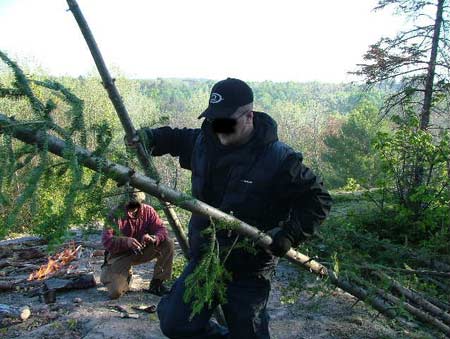 |
This system has many
advantages. We were training in bug season and there
were a lot of bugs.
So I have what I call "bows bush bed" as an "option".
We start with some pieces of leftover materials like
seen here. |
|
|
|
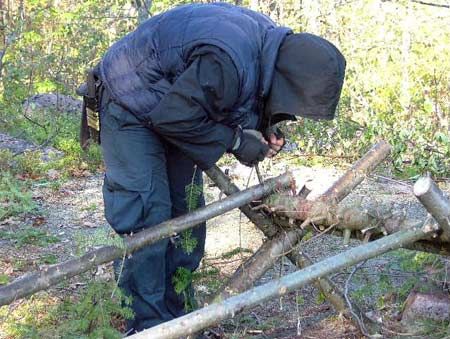 |
Then I will find a spot to
hold them up off the ground -- this can be between two
trees, or on this bench as seen here. |
|
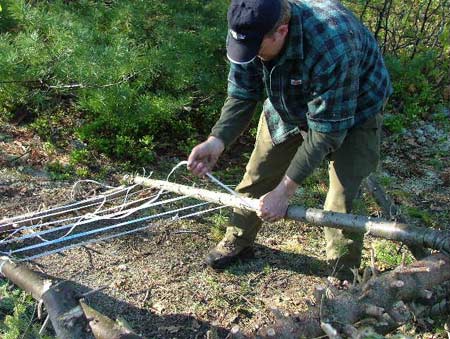 |
Then I start by using
cordage and weaving a horizontal pattern first (I am,
for the purpose of this demo, using a white cordage to
better illustrate my process, and it is quite a bit
larger than needed). |
|
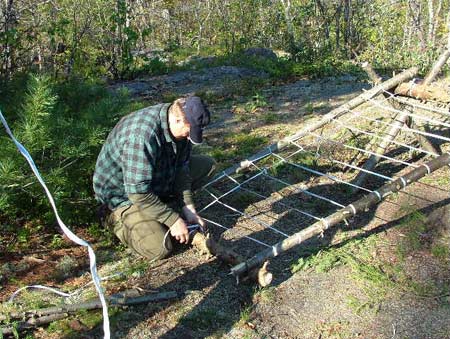 |
Next, I will start my
vertical weaving pattern which now will start to tighten
and solidify this pattern. |
|
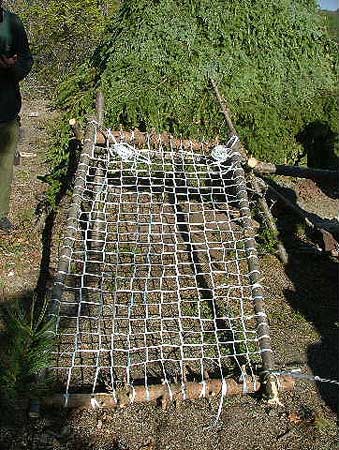 |
Once I have completed the
two weaving patterns you should end up with something
that looks like this. |
|
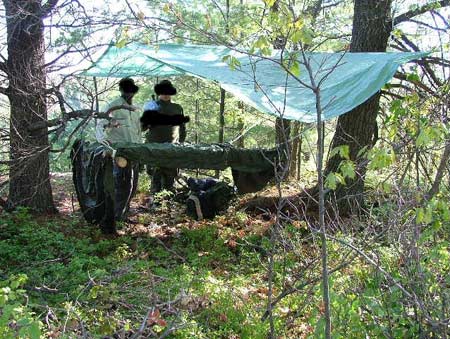 |
Now at this point we take
this bed and tie it in the trees, finding three trees as
I have here is the easiest. I have then placed a ground
sheet on the top of it, and my tarp is over that, to
keep the rain off. |
|
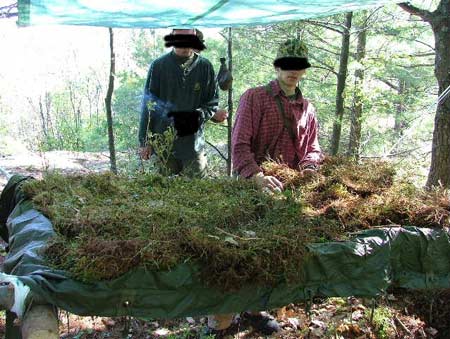 |
Now I collect some moss
and place it over the ground sheet -- this forms my
sleeping pad! It makes this system very comfortable. You
can use one sheet under you and one over you later for
your sleeping bag if desired, or you don't have a
sleeping bag. |
|
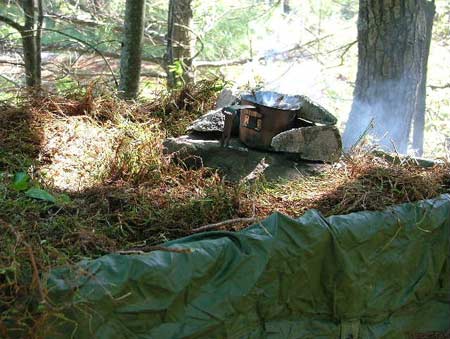 |
To complete my system,
especially in the bug season, I place a fire pit on the
moss at the foot of my bed, then a smudge pot to ward
off the bugs. This system has a lot of option attached
to it, as I outlined to these troops.
I especially like it in the fall in the wet season
because it offers me a dry platform with which to work,
it is extremely comfortable, and it is easy to set up.
This size as seen here is bigger than I normally make
them, but for this demo it help visualize the idea. |
|
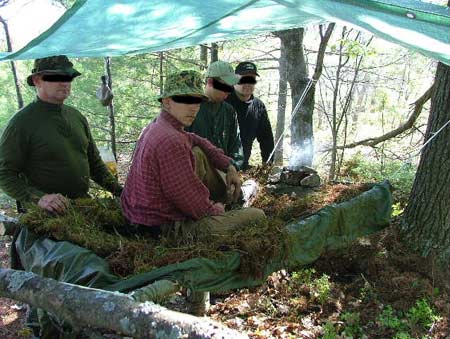 |
As seen here, this bed is
very stable and very comfortable! And is a great bug/wet
weather system, that I have used a lot. This is one of
my versions of this system I use. I have in the bush
used many variations of this depending on the conditions
I encounter. |
|
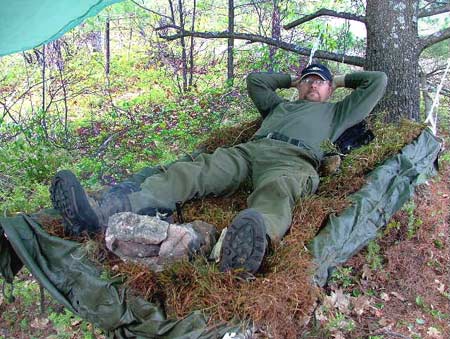 |
And comfortable it is! I
like to enjoy my works as well as the next man. It is
a great "option" as I always say in the bush. |
|
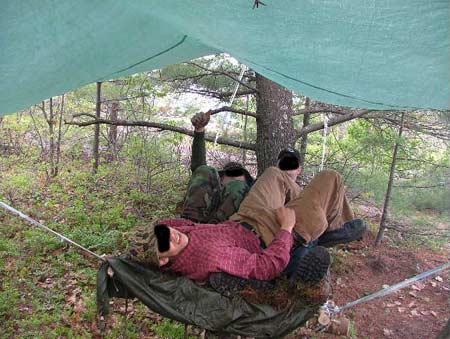 |
And, how stable and strong is this
"bow's bush bed''? Well here is over 500 lbs of
soldiers on this system and it is still hanging
there!
|
|
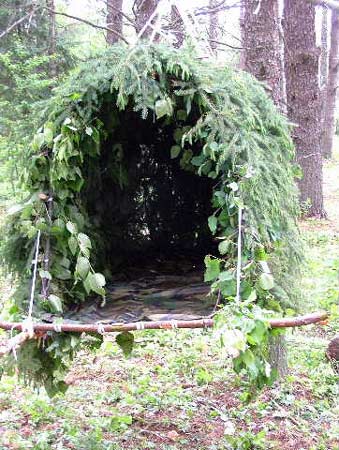 |
Above, I have demonstrated the bed section hanging
off the ground with a tarp overhead and left it open
on purpose,
to show you the workings of the interior. Now this
picture here depicts how I usually complete my "bows
bush bed". This would be the cover on this shelter
system (imagine this added to the pictures you
viewed earlier). Seen here, yes, it is hanging off
the ground! Some of the shelters I use, I will hang
them like this, especially in a very wet area, or if
there's a chance of a very wet day coming. Shown on
this angle, I have left the front section not
completed in order to allow viewing of the inside.
What has to be completed now, is adding my moss
sheets, and my stone and pot for my smudge, and my
small smoke vent. This system is ALMOST COMPLETED! |
|
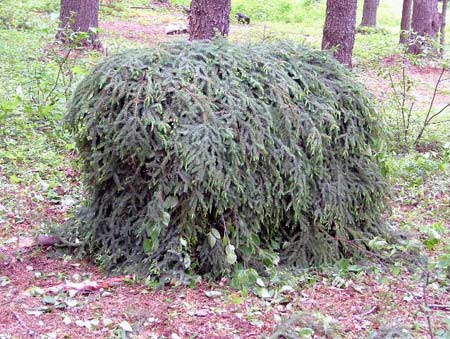 |
Here is a side view of the same shelter, but resting
on the ground. Sometimes with my shelters,
depending on the season, I often leave one end open
to allow easy access into the interior and a good
exchange of air, especially in the hot seasons or
bug season. However, in late fall I would enclose
the system, leaving a small opening at the side to
allow access into this shelter.
This system, set up as you see here, offers a lot
of advantages to a bush wonderer. Some easily seen
and some not understood till you have slept in them.
|
|
|
I have many more ideas with these kinds of shelters. When people show up and I
take them on trips in the bush to "live" the process, I like then to depict many
more ideas that follow some of my "bush shelters". I have found that by working
in all four seasons as I do, many new "options" for shelters come up that I have
worked with and found beneficial for each season. There always seems to be
something new nature has in store for skills. I am always amazed! When viewing
some pictures of my articles, it often seems easy to see it being developed, and
it doesn't seem as though it would be a very tough task to go out in the bush
when in need of an " option" and work out some of these ideas. However, seeing
it being done, and actually going in the bush alone and in need of some bush
skills is altogether a different thing! Trust me on this -- there is no
substitute for practice! No other way.
--Allan bow
Beauchamp |
|
|
|
|